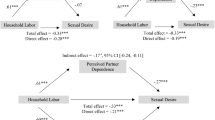Abstract
This paper describes the development of the Battered Women Scale (BWS), an instrument based on the Personal Attributes Questionnaire (PAQ) designed by Spence, Helmreich and Stapp (1974) and widely used to measure gender role trait ascription. Following arguments in the literature that battered women have particular traits, and the argument here that these traits are caused by experiences in battering relationships, the BWS was shown to successfully differentiate between women in three shelter houses and a sample of similar women who claim no abuse in their past. Further, although African-American women were generally very different in their gender role trait ascriptions than White women, they had patterns of reaction to battering very similar to white women. It is suggested that the BWS can be very useful to measure the value to battered women of shelter house programming on self-concepts.
Similar content being viewed by others
References
Asbury, J. (1987). African-American women in violent relationships. In R. L. Hampton (ed.),Violence in the Black Family, Lexington Books, Lexington, MA, pp. 89–105.
Ball, M. (1977). Issues of violence in family casework.Social Casework, 58: 3–12.
Bem, S. L. (1974). The measurement of psychological androgyny.J. Consult. Clin. Psychol. 42: 155–162.
Burke, P., Stets, J., and Pirog-Good, M. (1988). Gender identity, self-esteem and physical and sexual abuse in dating relationships.Social Psychol. Quart. 51: 272–283.
Coley, S. M., and Beckett, J. O. (1988). Black battered women: practice issues.Social Casework, 69: 483–490.
Constantinople, A. (1973). Masculinity-femininity: An exception to a famous dictum?Psychological Bull. 80: 389–407.
Denzin, N. K. (1984). Toward a phenomenology of domestic, family violence.Am. J. Sociol. 90: 483–513.
Denzin, N. K. (1966). The significant others of a college population.Sociol. Quart. 7: 298–310.
Dutton, D. G. (1987). Wife assault: Social psychological contributions to criminal justice policy. In S. Oskamp, (ed.),Family Processes and Problems: Social Psychological Aspects, Sage, Beverly Hills, CA: pp. 238–261.
Finkelhor, D. (1983). Common features of family violence. In D. Finkelhor, R. Gelles, G. Hotaling, and M. Straus (eds.),The Dark Side of Families: Current Family Violence Research, Sage, Beverly Hills, CA, pp. 17–28.
Finn, J. (1985). Stresses and coping behavior of battered women.Social Casework, 66: 341–349.
Geffner, R., and Pagelow, M. D. (1990). Victims of spouse abuse. In R. Ammerman and M. Hersen (eds.),Treatment of Family Violence, Wiley, New York, pp. 113–135.
Hedlund, B., and Lindquist, C. U. (1984). The development of an inventory for distinguishing among passive, aggressive and assertive behavior.Behav. Assess. 6: 379–390.
Hilberman, E. (1980). Overview: the wifebeater's wife reconsidered.Am. J. Psychiatry 137: 1336–47.
Homer, M., Leonard, A., and Taylor, P. (1985). Personal relationships. In Johnson, N. (ed.),Marital Violence, Routledge & Kegan Paul, London, pp. 77–92.
Luckenbill, D. F. (1979). Power: A conceptual framework.Symbolic Interact. 2: 97–113.
Mam, A. (1989). Violence against black women.Fern. Rev. 32: 30–48.
Mattley, C. L., and Schwartz, M. D. (1990). Emerging from tyranny.Symbolic Interact. 13: 281–289.
McGuire, W., and Pawader-Singer, A. (1982). Trait salience in the spontaneous self-concept. In M. Rosenberg and H. Kaplan (eds.),Social Psychology of the Self-Concept, Harlan Davidson, Arlington Heights, IL, pp. 24–57.
Miller, D. E., Weiland, M. W., and Couch, C. J. (1978). Tyranny. In N. Denzin (ed.),Annual Studies in Symbolic Interaction, Vol. 1, JAI Press, Greenwich, CT, pp. 267–288.
Pagelow, M. D. (1981).Woman Battering, Sage, Beverly Hills, CA.
Rasche, C. (1988). Minority women and domestic violence.J. Contemp. Crim. Justice 4: 150–171.
Richie, B. (1985). Battered black women.The Black Scholar 16: 40–44.
Rosenberg, M. (1979).Conceiving the Self, Basic Books, New York.
Rosenberg, M. (1981). The self-concept. In M. Rosenberg and R. Turner (eds.),Social Psychology, Basic Books, New York, pp. 593–624.
Schwartz, M. D. (1988). Marital status and woman abuse theory.J. Fam. Viol. 3: 239–248.
Schwartz, M. D. (1989). Asking the right questions: Battered women are not all passive.Sociol. View. 5: 46–61.
Shainess, N. (1977). Psychological aspects of wife beating. In M. Roy (ed.),Battered Women, Van Nostrand Reinhold, New York, pp. 111–119.
Smith, M. D. (1990). Sociodemographic risk factors in wife abuse: Results from a survey of Toronto women.Canad. J. Sociol. 15: 39–58.
Spence, J. T., Helmreich, R. L., and Stapp, J. (1974). The personal attributes questionnaire.JSAS Cat. Select. Doc. Psychol. 4: 43.
Spence, J. T., and Helmreich, R. L. (1978).Masculinity and femininity, University of Texas Press, Austin.
Starr, B. (1978). Comparing battered and non-battered women.Victimology 3: 37–44.
Turner, R. (1956). Role taking, role standpoint and reference group behavior.Am. J. Sociol. 61: 316–328.
Walker, L. E. (1979).The Battered Woman, Harper & Row, New York.
Walker, L. E. (1989).Terrifying Love, Harper & Row, New York.
Author information
Authors and Affiliations
Rights and permissions
About this article
Cite this article
Schwartz, M.D., Mattley, C.L. The battered woman scale and gender identities. J Fam Viol 8, 277–287 (1993). https://doi.org/10.1007/BF00988773
Issue Date:
DOI: https://doi.org/10.1007/BF00988773




